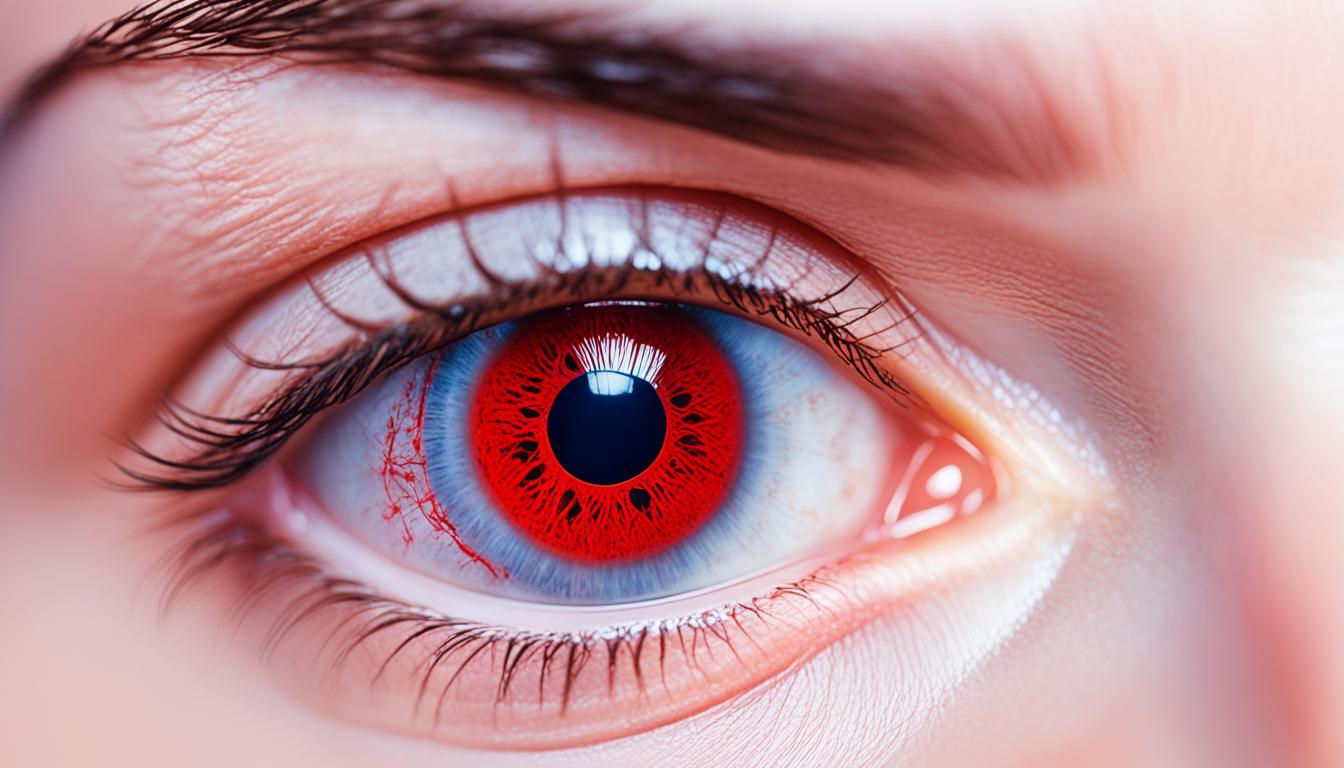Ocular rosacea is a common, long-term skin condition that affects the eyes in 58-72% of those diagnosed. It often shows up in issues like blepharitis and meibomian gland dysfunction. Other symptoms like conjunctival hyperemia and corneal challenges can occur. The exact causes are not fully known. However, experts think it typically results from both blood vessel and immune issues. Spotting ocular rosacea can be tough. This is because there might not be obvious skin changes. A doctor will mostly rely on what they see during an eye exam. To help, there are several ways to treat it. These include using special eye drops, keeping the eyelids clean, and for very bad cases, stem cell therapy can be an option.
Key Takeaways:
- Ocular rosacea affects the eyes in a large percentage of its patients.
- Its symptoms involve issues like blepharitis and meibomian gland dysfunction, along with a few others.
- We are not entirely sure what causes it, though malfunctioning blood vessels and immune responses are prominent theories.
- Spotting ocular rosacea can be hard, especially at first, because the skin may not look different.
- Treatments range from simple eye drops and clean eyelids to more advanced stem cell therapy in severe cases.
Prevalence and Clinical Features of Ocular Rosacea
Ocular rosacea is a common eye issue linked to rosacea. It affects men and women equally. About 58-72% of people with rosacea also have ocular rosacea.
Ocular rosacea doesn’t just affect the eyes. It can lead to eye problems and inflammation, needing the right treatment and care.
The main signs of ocular rosacea are blepharitis, meibomian gland dysfunction, conjunctival hyperemia, and eyelid margin telangiectasias. These problems can make your eyes burn, sting, or feel like something’s in them. They can also cause your eyes to water.
Sometimes, ocular rosacea shows up without any skin symptoms at all. And in rare cases, eye issues might come before skin changes. Early diagnosis and treatment are crucial. They can stop further eye problems and make life better for those with ocular rosacea.
Clinical Features of Ocular Rosacea:
- Blepharitis
- Meibomian gland dysfunction
- Conjunctival hyperemia
- Eyelid margin telangiectasias
Knowing the signs of ocular rosacea is key. It’s often missed or wrongly diagnosed. So, getting your eyes checked often is important, especially if you’ve had rosacea before.
Learning about ocular rosacea and its symptoms helps you manage your eye health better. Seek medical help when needed to prevent further issues.
Pathophysiology and Corneal Complications of Ocular Rosacea
Ocular rosacea impacts the eyes in a complicated way. It mixes issues with blood vessels and the immune system. We know that too much bacteria, swelling, and how the immune system reacts are big parts of the disease.
Corneal issues, though not common, can happen to about a third of ocular rosacea patients. They can really affect how well you see. Problems might include small injuries on the corneal surface, swollen tissue inside the cornea, making it thin, new blood vessels growing, and spots where the tissue is hurt.
Doctors aim to lower swelling, ease symptoms, and stop the disease from getting worse to save the cornea. You might get some eye drops or other creams to feel better and reduce swelling.
If you have ocular rosacea, your eyes need careful watching for cornea problems. If these aren’t treated, your eyesight could get worse. Seeing an eye doctor regularly is crucial to keep track of how the disease is moving and changing your treatment when necessary.
Corneal Complications of Ocular Rosacea
The cornea, the eye’s clear front part, can face different issues with ocular rosacea. These can make you see less clearly and feel uncomfortable. The table below shows the main corneal problems related to ocular rosacea:
| Corneal Complication | Description |
|---|---|
| Punctate Epithelial Erosions | Small ulcers or injuries on the corneal surface can make you feel like there’s dirt in your eye. You might also feel very sensitive to light. |
| Stromal Infiltrates | Too many inflammation cells reaching the corneal stroma can make it look cloudy and you might see less clearly. |
| Corneal Thinning | The cornea gets weaker and thinner, which isn’t stable and can make things look odd. |
| Neovascularization | Immature blood vessels grow on the corneal surface, showing up red and inflamed. |
| Scarring | Fibrous tissue forms on the cornea, making your vision go bad forever. |
Finding and dealing with corneal problems early is key to not losing your vision for good. In tough cases, when normal treatments do not work well, doctors might suggest newer treatments, like using stem cells, to fight swelling and keep the cornea healthy.
Knowing the disease process and what might go wrong with the cornea, doctors can give better care. This means the disease is less likely to hurt how you see and your life overall.
Conclusion
Ocular rosacea is quite common, affecting many people’s eye health. Getting diagnosed and treated early is important to avoid serious issues and get better. Treatment can involve using creams on the eyes, keeping the eyelids clean, and sometimes even stem cell therapy.
It’s key to follow up with the doctor to make sure the treatment is working. Also, this helps spot and fix any new eye problems. By treating both the symptoms and what’s causing them, patients can improve their eye health and quality of life.

